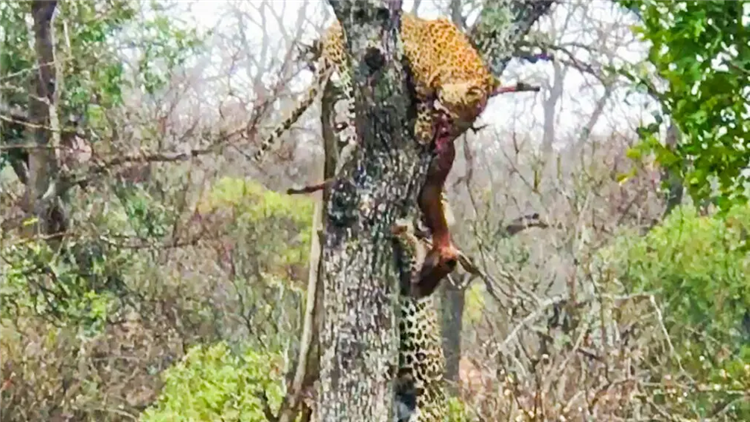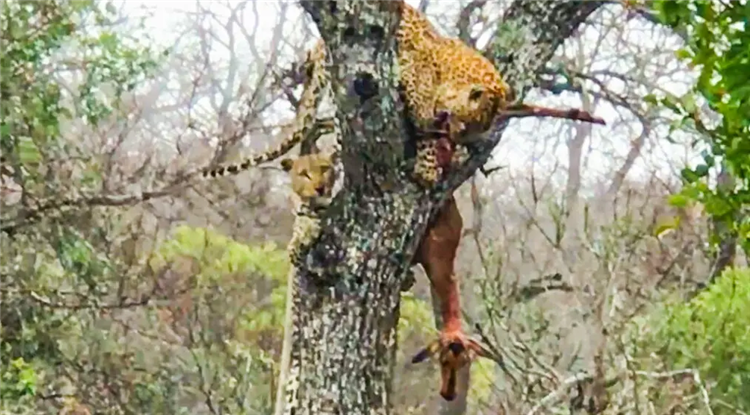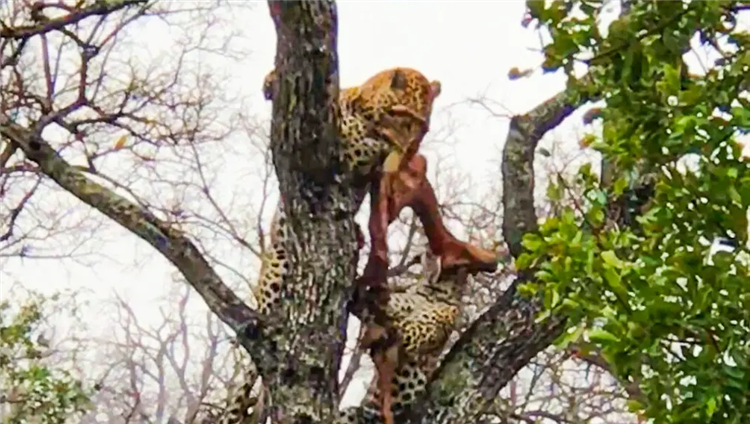A leopard fights with her cub over a meal. Eventually breaking free, she jumps from a tall tree and does not land on her feet
Michele Bron was able to capture the entire scene on video and shared it with LatestSightings.com.
“My guide and I had spotted a leopard who had taken down an impala. We found her resting on a tree, feeding on her kill. We made a decision the next morning to return to the site and perhaps get some well-lit photographs.”

Why do leopards carry their kills up trees? The answer is simple: It’s for protection. By hoisting their kill up high, they can keep it away from other predators, such as lions and hyenas, who might try to steal it. The higher vantage point of a tree allows the leopard to keep an eye on any potential threats and safely enjoy their meal.
“However, the next morning, the leopard and the impala carcass were not to be found. What happened next was something I will never forget. We found the mother leopard and her cub fighting over the impala’s remains, and things quickly escalated.”
Leopards are solitary animals, but they form strong bonds with their young. Cubs typically stay with their mother until they are around two years old and are capable of surviving on their own. During this time, the mother will teach her cubs how to hunt and protect themselves. However, once the cubs reach maturity, they will leave their mother and establish their own territory.

“The mother and cub were locked in a tug of war that seemed to go on for an eternity when eventually the cub lost her grip on the kill. We are used to seeing leopards land gracefully on their feet. However, the mother landed very awkwardly on her back with the kill in her mouth. She quickly regained her composure and ran off.”
Observing wildlife in their natural habitat is an experience like no other. From learning about their behavior and family dynamics to witnessing jaw-dropping moments, each encounter with wildlife teaches us something new.
The leopard (Panthera pardus), commonly known as the leopard for short, is one of five species of big cats of the genus Panthera that live in Africa and Asia. They are from 1 to nearly 2 meters long, weighing from 30 to 90 kg. Females are typically about two-thirds the size of males. Although relatively small compared to other big cats, leopards are dangerous predators.[2] Their legendary snooping ability and the ability to eat anything from scarabs and up have made them the most successful of the Surviving Cats.

The common English name “leopard” (/ˈlɛpərd/) is a combination of the Greek words λέωλέω leōn (“lion”) and posς pardos (“male leopard”). The name reflects the fact that in ancient times it was thought that the leopard was a hybrid of a lion and a jaguar, and in some foreign languages the word leopard is derived from this; leo is the Latin name for lion, and pard is the old term for leopard. This Greek word is related to Sanskrit ा ABLE ु pṛdāku (“snake”, “tiger” or “leopard”), and is probably derived from a Mediterranean language, such as Egyptian. The name was first used in the 13th century. In fact, “leopard” may have been several species of the Cat family that have a gene for black rather than fawn, thus giving a pure black coat. , in contrast to those with the usual spot color. “Leopards”, in another sense, are simply dark-haired leopards (or the dark form of other giant cats). Other local names for leopards include graupanther, panther and some regional names such as tendwa in India. The term “black panther” refers to leopards with the melanoma gene. A term for leopard used in Old English and later, but now very uncommonly, is “pard”.

The scientific name of the leopard is Panthera pardus. The common name Panthera is derived from Latin via Greek πάάθηρ (pánthēr). The term “panther”, first used as recorded in the 13th century, usually refers to the leopard and less frequently the cougar and the jaguar. Proposed alternate origins for Panthera include an Indo-Iranian word meaning “white-yellow” or “pale”. In Sanskrit, the word can be derived from पाण ड pāṇḍara (“tiger”), which in turn comes from पुण डडडṇḍṇḍṇḍṇḍṇḍṇḍ. The specific name pardus is derived from the Greek word (pardos) (“male leopard”).
Since Carl Linnaeus published his description of a leopard in Systema Naturae in 1758, as many as 27 leopard subspecies were subsequently described by naturalists between 1794 and 1956. Between 1996, According to mitochondrial DNA analysis performed in the 1990s, only eight subspecies were considered valid.[3] Subsequent analysis indicated a ninth valid subspecies, the Arabian leopard. Due to limited sampling of African leopards, this number may be underestimated.[4]